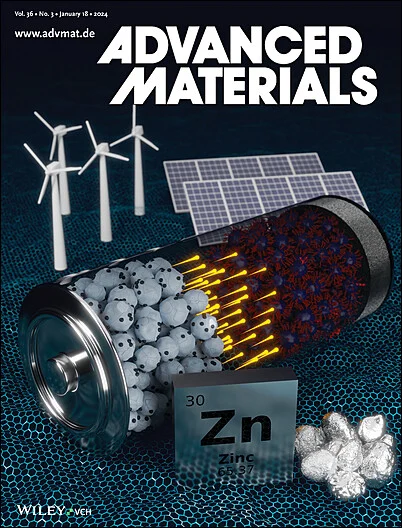Tunable Magnetism and Intrinsic Exchange Bias in Al-Substituted Terbium Iron Garnet.
IF 26.8
1区 材料科学
Q1 CHEMISTRY, MULTIDISCIPLINARY
引用次数: 0
Abstract
Ferrimagnetic insulators are central to both fundamental magnetism and diverse technologies, including spintronics, photonics, and microwave engineering. Their low damping, electrical insulation, and tunable magnetism make them ideal, especially for low-power spintronic devices. Controlling key magnetic properties -particularly the magnetic compensation- is essential for accessing ultrafast dynamics, and advanced spintronic functionalities. Here, it is demonstrated that the magnetic compensation temperature (TM) of an archetype ferrimagnetic insulator, terbium iron garnet (Tb3Fe5O12, TbIG), can be continuously tuned and raised to ambient temperature by partially substituting magnetic Fe atoms with nonmagnetic Al. This substitution, achieved by high-temperature co-sputtering of TbIG and Al2O3, is confirmed by atomically resolved electron microscopy. Near TM, a giant intrinsic exchange bias of up to 2.5 kOe is observed. The exchange bias exhibits deterministic or stochastic behavior depending on the cooling conditions, and its polarity can be controlled via an external magnetic field. To explain the observed phenomena, a phenomenological model is developed that takes into account a distribution of local TM values induced by magnetic site disorder. These findings provide an efficient strategy for controlling TM and enabling exchange bias in TbIG that may add new functionalities for room-temperature spintronic and photonic applications.铝取代铽铁石榴石的可调谐磁性和本征交换偏置。
铁磁绝缘体是基础磁学和各种技术的核心,包括自旋电子学、光子学和微波工程。它们的低阻尼、电绝缘和可调谐磁性使它们成为理想的材料,特别是用于低功率自旋电子器件。控制关键的磁性-特别是磁补偿-是获得超快动力学和先进的自旋电子功能的必要条件。本文证明了一种原型铁磁绝缘体铽铁石榴石(Tb3Fe5O12, TbIG)的磁补偿温度(TM)可以通过用非磁性Al原子部分取代磁性Fe原子而连续调谐并提高到环境温度。这种取代是通过TbIG和Al2O3的高温共溅射实现的,并通过原子分辨电镜证实了这一点。在TM附近,观察到高达2.5 kOe的巨大内在交换偏置。交换偏置根据冷却条件表现出确定性或随机行为,其极性可以通过外部磁场控制。为了解释观测到的现象,建立了一个考虑磁位紊乱引起的局部TM值分布的现象学模型。这些发现为TbIG中控制TM和实现交换偏置提供了一种有效的策略,可能为室温自旋电子和光子应用增加新的功能。
本文章由计算机程序翻译,如有差异,请以英文原文为准。
求助全文
约1分钟内获得全文
求助全文
来源期刊

Advanced Materials
工程技术-材料科学:综合
CiteScore
43.00
自引率
4.10%
发文量
2182
审稿时长
2 months
期刊介绍:
Advanced Materials, one of the world's most prestigious journals and the foundation of the Advanced portfolio, is the home of choice for best-in-class materials science for more than 30 years. Following this fast-growing and interdisciplinary field, we are considering and publishing the most important discoveries on any and all materials from materials scientists, chemists, physicists, engineers as well as health and life scientists and bringing you the latest results and trends in modern materials-related research every week.
 求助内容:
求助内容: 应助结果提醒方式:
应助结果提醒方式:


